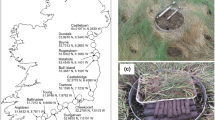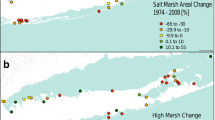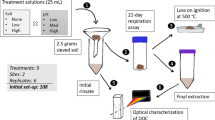Abstract
Saltmarshes provide a broad range of high-value ecosystem services and can be sensitive to eutrophication, but elucidating such impacts at broad spatial scales demands a better understanding of the underlying nutrient linkages between saltmarsh soil and tidal waters. We used existing water quality data and field surveys of 15 saltmarshes across a broad trophic gradient of coastal waters, but similar biogeographic setting (in Ireland) to investigate if phosphorus and nitrogen pools in saltmarsh soils are related to those in tidal water across saltmarshes. We also investigated if the strength of such relationships is inversely related to ground elevation, which approximates the degree of tidal inundation. Plant-available phosphorus and nitrogen pools in soil were related to water nutrients, albeit only weakly. We did not find any support for the moderating influence of elevation, indicating that it may be obscured by internal cycling and external sources. We also found evidence for effect of birds on the saltmarsh nutrient pool. Saltmarsh soils are unlikely to serve as general sentinels of nutrient conditions in their corresponding water bodies and may need separate assessment criteria and management tools, which in turn require disentangling localised and whole-saltmarsh sources of variation in nutrient concentrations.







Similar content being viewed by others
References
Abd Aziz, S.A., and D.B. Nedwell. 1986a. The nitrogen cycle of an East Coast, U.K., saltmarsh: I. Nitrogen assimilation during primary production; detrital mineralization. Estuarine, Coastal and Shelf Science 22: 559–575.
Abd Aziz, S.A., and D.B. Nedwell. 1986b. The nitrogen cycle of an East Coast, U.K. saltmarsh: II. Nitrogen fixation, nitrification, denitrification, tidal exchange. Estuarine, Coastal and Shelf Science 22: 689–704.
Adam, P. 2002. Saltmarshes in a time of change. Environmental Conservation 29: 39–61.
Barnes, A.D., M. Jochum, J.S. Lefcheck, N. Eisenhauer, C. Scherber, M.I. O’Connor, P. de Ruiter, and U. Brose. 2018. Energy flux: the link between multitrophic biodiversity and ecosystem functioning. Trends in Ecology and Evolution. 33 (3): 186–197.
Beeftink, W.G., and J. Rozema. 1988. The nature and functioning of salt marshes. In Pollution of the North Sea: an assessment, ed. W. Salomons, B.L. Bayne, E.K. Duursma, and U. Förstner, 59–87. Berlin: Springer Berlin Heidelberg.
Bertness, M.D., C. Crain, C. Holdredge, and N. Sala. 2008. Eutrophication and consumer control of New England salt marsh primary productivity. Conservation Biology. 22 (1): 131–139.
Best, M., A. Massey, and A. Prior. 2007. Developing a saltmarsh classification tool for the European water framework directive. Marine Pollution Bulletin 55 (1-6): 205–214.
Birk, S., W. Bonne, A. Borja, S. Brucet, A. Courrat, S. Poikane, A. Solimini, W. van de Bund, N. Zampoukas, and D. Hering. 2012. Three hundred ways to assess Europe’s surface waters: an almost complete overview of biological methods to implement the water framework directive. Ecological Indicators 18: 31–41.
Borcard, D., F. Gillet, and P. Legendre. 2011. Numerical ecology with R. New York: Springer.
Boudsocq, S., A. Niboyet, J.C. Lata, X. Raynaud, N. Loeuille, J. Mathieu, M. Blouin, L. Abbadie, and S. Barot. 2012. Plant preference for ammonium versus nitrate: a neglected determinant of ecosystem functioning? The American Naturalist 180 (1): 60–69.
Cargill, S.M., and R.L. Jefferies. 1984. Nutrient limitation of primary production in a sub-Arctic salt marsh. Journal of Applied Ecology 21 (2): 657–668.
Clarke, P.J. 1985. Nitrogen pools and soil characteristics of a temperate estuarine wetland in eastern Australia. Aquatic Botany 23 (3): 275–290.
Curtis, T.G.F., and M. Sheehy Skeffington. 1998. The salt marshes of Ireland: an inventory and account of their geographical variation. Biology and Environment: Proceedings of the Royal Irish Academy 98B: 87–104.
Daly, D., M. Archbold, and J. Deakin. 2016. Progress and challenges in managing our catchments effectively. Biology and Environment: Proceedings of the Royal Irish Academy 116B: 157–166.
de Groot, R., L. Brander, S. van der Ploeg, R. Costanza, F. Bernard, L. Braat, M. Christie, N. Crossman, A. Ghermandi, L. Hein, S. Hussain, P. Kumar, A. McVittie, R. Portela, L.C. Rodriguez, P. ten Brink, and P. van Beukering. 2012. Global estimates of the value of ecosystems and their services in monetary units. Ecosystem Services 1 (1): 50–61.
De Laune, R.D., C.N. Reddy, and W.H. Patrick. 1981. Effect of pH and redox potential on concentration of dissolved nutrients in an estuarine sediment. Journal of Environmental Quality 10 (3): 276–279.
Deegan, L.A., D.S. Johnson, R.S. Warren, B.J. Peterson, J.W. Fleeger, S. Fagherazzi, and W.M. Wollheim. 2012. Coastal eutrophication as a driver of salt marsh loss. Nature 490 (7420): 388–392.
Dentener, F., J. Drevet, J.F. Lamarque, I. Bey, B. Eickhout, A.M. Fiore, D. Hauglustaine, L.W. Horowitz, M. Krol, U.C. Kulshrestha, M. Lawrence, C. Galy-Lacaux, S. Rast, D. Shindell, D. Stevenson, T. Van Noije, C. Atherton, N. Bell, D. Bergman, T. Butler, J. Cofala, B. Collins, R. Doherty, K. Ellingsen, J. Galloway, M. Gauss, V. Montanaro, J.F. Müller, G. Pitari, J. Rodriguez, M. Sanderson, F. Solmon, S. Strahan, M. Schultz, K. Sudo, S. Szopa, and O. Wild. 2006. Nitrogen and sulfur deposition on regional and global scales: a multimodel evaluation. Global Biogeochemical Cycles 20 (4). https://doi.org/10.1029/2005GB002672.
Devaney, F.M., and P.M. Perrin. 2015. Saltmarsh angiosperm assessment tool for Ireland (SMAATIE). Wexford: Environmental Protection Agency.
Dray, S., G. Blanchet, D. Borcard, S. Clappe, G. Guenard, T. Jombart, G. Larocque, P. Legendre, N. Madi, and H.H. Wagner. 2017. Adespatial: multivariate multiscale spatial analysis. R package version 0.0–9. https://CRAN.R-project.org/package=adespatial. Accessed 03 July 2018.
EC. 2013. The values of the member state monitoring system classifications as a result of the intercalibration exercise and repealing decision 2008/915/EC. Official Journal of the European Union L266: 1–47.
Elser, J.J., M.E.S. Bracken, E.E. Cleland, D.S. Gruner, W.S. Harpole, H. Hillebrand, J.T. Ngai, E.W. Seabloom, J.B. Shurin, and J.E. Smith. 2007. Global analysis of nitrogen and phosphorus limitation of primary producers in freshwater, marine and terrestrial ecosystems. Ecology Letters 10 (12): 1135–1142.
EPC. 2000. Water framework directive 2000/60/EC establishing a framework for community action in the field of water policy. Official Journal of the European Communities L327: 1–73.
Falkengren-Grerup, U. 1995. Interspecies differences in the preference of ammonium and nitrate in vascular plants. Oecologia 102 (3): 305–311.
Fanning, A., M. Craig, P. Webster, C. Bradley, D. Tierney, R. Wilkes, A. Mannix, P. Treacy, F. Kelly, R. Geoghegan, T. Kent, and M. Mageean. 2017. Water quality in Ireland 2010–2015. Wexford: Environmental Protection Agency.
Fox, J., and S. Weisberg. 2011. An {R} companion to applied regression. Thousand Oaks: Sage Publishing.
García, P., E. Zapico, and A. Colubi. 2009. An angiosperm quality index (AQI) for Cantabrian estuaries. Ecological Indicators 9 (5): 856–865.
Gardner, L.R. 2005. A modeling study of the dynamics of pore water seepage from intertidal marsh sediments. Estuarine, Coastal and Shelf Science 62 (4): 691–698.
Henry, J., and J. Aherne. 2014. Nitrogen deposition and exceedance of critical loads for nutrient nitrogen in Irish grasslands. Science of the Total Environment 470: 216–223.
Henry, H.A.L., and R.L. Jefferies. 2003. Interactions in the uptake of amino acids, ammonium and nitrate ions in the Arctic salt-marsh grass, Puccinellia phryganodes. Plant, Cell and Environment 26 (3): 419–428.
Johnson, D.S., R.S. Warren, L.A. Deegan, and T.J. Mozdzer. 2016. Saltmarsh plant responses to eutrophication. Ecological Applications 26 (8): 2649–2661.
Kiehl, K., P. Esselink, and P.J. Bakker. 1997. Nutrient limitation and plant species composition in temperate salt marshes. Oecologia 111 (3): 325–330.
Ligeza, S., and H. Smal. 2003. Accumulation of nutrients in soils affected by perennial colonies of piscivorous birds with reference to biogeochemical cycles of elements. Chemosphere 52 (3): 595–602.
Maynard, D.G., Y.P. Kalra, and J.A. Crumbaugh. 2008. Nitrate and exchangeable ammonium nitrogen. In Canadian Society for Soil Science: Soil Sampling and Methods of Analysis, ed. M.R. Carter and E.G. Gregorich, vol. 59, 2nd ed., 71–80. Boca Raton: CRC Press.
McCorry, M., and T. Ryle. 2009. Saltmarsh monitoring project 2007–2008. Dublin: National Parks and Wildlife Service.
Milner, A.M., C.L. Fastie, F.S. Chapin, D.R. Engstrom, and L.C. Sharman. 2007. Interactions and linkages among ecosystems during landscape evolution. BioScience 57 (3): 237–247.
O'Boyle, S., R. Wilkes, G. McDermott, S. Ní Longphuirt, and C. Murray. 2015. Factors affecting the accumulation of phytoplankton biomass in Irish estuaries and nearshore coastal waters: a conceptual model. Estuarine, Coastal and Shelf Science 155: 75–88.
Perrin, P.M. 2016. Irish vegetation classification: technical progress report no. 2. Waterford: National Biodiversity Data Centre. http://www.biodiversityireland.ie/ivc. Accessed 15 June 2018.
R Core Team. 2018. R: A language and environment for statistical computing. Vienna: R Foundation for Statistical Computing, version 3.5.0. http://www.R-project.org. Accessed 03 July 2018.
Ravenek, J.M., H. Bessler, C. Engels, M. Scherer-Lorenzen, A. Gessler, A. Gockele, E. De Luca, V.M. Temperton, A. Ebeling, C. Roscher, B. Schmid, W.W. Weisser, C. Wirth, H. de Kroon, A. Weigelt, and L. Mommer. 2014. Long-term study of root biomass in a biodiversity experiment reveals shifts in diversity effects over time. Oikos 123 (12): 1528–1536.
Rozema, J., P. Leendertse, J. Bakker, and H. Wijnen. 2000. Nitrogen and vegetation dynamics in European salt marshes. In Concepts and controversies in tidal marsh ecology, ed. M.P. Weinstein and D.A. Kreeger, 469–491. Dordrecht: Springer.
Scanlan, C.M., J. Foden, E. Wells, and M.A. Best. 2007. The monitoring of opportunistic macroalgal blooms for the water framework directive. Marine Pollution Bulletin 55 (1-6): 162–171.
Schoenau, J.J., and I.P. O'Halloran. 2008. Sodium bicarbonate-extractable phosphorus. In Canadian society for soil science: Soil sampling and methods of analysis, ed. M.R. Carter and E.G. Gregorich, vol. 59, 2nd, 89–94. Boca Raton: CRC Press.
Schrama, M., J. Jouta, M.P. Berg, and H. Olff. 2013a. Food web assembly at the landscape scale: using stable isotopes to reveal changes in trophic structure during succession. Ecosystems 16 (4): 627–638.
Schrama, M., P. Heijning, J.P. Bakker, van H.J. Wijnen, M.P. Berg, and H. Olff. 2013b. Herbivore trampling as an alternative pathway for explaining differences in nitrogen mineralization in moist grasslands. Oecologia 172: 231–243.
Schrama, M., L.A. van Boheemen, H. Olff, and M.P. Berg. 2015. How the litter-feeding bioturbator Orchestia gammarellus promotes late-successional saltmarsh vegetation. Journal of Ecology 103 (4): 915–924.
Silliman, B.R., and M.D. Bertness. 2002. A trophic cascade regulates salt marsh primary production. Proceedings of the National Academy of Sciences 99 (16): 10500–10505.
Smith, V.H., and D.W. Schindler. 2009. Eutrophication science: where do we go from here? Trends in Ecology and Evolution 24 (4): 201–207.
Tsyro, S., W. Aas, S. Solberg, A. Benedictow, H. Fagerli, and M. Posch. 2017. Status of transboundary air pollution in 2015. In European monitoring and evaluation programme status report 2017: transboundary particulate matter, photo-oxidants, acidifying and eutrophying components, 15–36. Oslo: Norwegian Meteorological Institute.
Valiela, I., and J.M. Teal. 1979. The nitrogen budget of a salt marsh ecosystem. Nature 280 (5724): 652–656.
Van Wijnen, H.J., and J.P. Bakker. 1999. Nitrogen and phosphorus limitation in a coastal barrier salt marsh: the implications for vegetation succession. Journal of Ecology 87 (2): 265–272.
Voulvoulis, N., K.D. Arpon, and T. Giakoumis. 2017. The EU water framework directive: from great expectations to problems with implementation. Science of the Total Environment 575: 358–366.
Walker, N.A., H.A.L. Henry, D.J. Wilson, and R.L. Jefferies. 2003. The dynamics of nitrogen movement in an Arctic salt marsh in response to goose herbivory: a parameterized model with alternate stable states. Journal of Ecology 91 (4): 637–650.
Wan, A.H.L., R.J. Wilkes, S. Heesch, R. Bermejo, M.P. Johnson, and L. Morrison. 2017. Assessment and characterisation of Ireland’s green tides (Ulva species). PLoS One 12 (1): e0169049.
Wang, L., and S.A. Macko. 2011. Constrained preferences in nitrogen uptake across plant species and environments. Plant, Cell and Environment 34 (3): 525–534.
Weis J.S., K.E.A. Segarra, and P. Bernal. 2016. Chapter 49: salt marshes. In The First global integrated marine assessment: world ocean assessment I. United Nations.
Wilkes, R., M. Bennion, N. McQuaid, C. Beer, G. McCullough-Annett, K. Colhoun, R. Inger, and L. Morrison. 2017. Intertidal seagrass in Ireland: pressures, WFD status and an assessment of trace element contamination in intertidal habitats using Zostera noltei. Ecological Indicators 82: 117–130.
Wong, J.X.W., C. Van Colen, and L. Airoldi. 2015. Nutrient levels modify saltmarsh responses to increased inundation in different soil types. Marine Environmental Research 104: 37–46.
Acknowledgments
The authors thank Sorcha Ní Longphuirt (EPA) for assistance in retrieving water quality data, and Yana Bersunukayeva and Alanna Kirwan for laboratory help. Fionnuala O’Neill and Emmi Virkki assisted with fieldwork. The authors also thank anonymous reviewers whose comments improved this manuscript.
Funding
This study was funded by the Environmental Protection Agency (EPA) as part of the SAMFHIRES project (Saltmarsh Function and Human Impacts in Relation to Ecological Status) (2015-W-MS-19).
Author information
Authors and Affiliations
Corresponding author
Additional information
Communicated by Nancy L. Jackson
Electronic supplementary material
Supplementary File 1
(DOCX 58.4 kb)
Supplementary File 2
(DOCX 308 kb)
Supplementary File 3
(DOCX 107 kb)
Rights and permissions
About this article
Cite this article
Penk, M.R., Wilkes, R., Perrin, P.M. et al. Nutrients in Saltmarsh Soils Are Weakly Related to those in Adjacent Coastal Waters. Estuaries and Coasts 42, 675–687 (2019). https://doi.org/10.1007/s12237-018-00486-x
Received:
Revised:
Accepted:
Published:
Issue Date:
DOI: https://doi.org/10.1007/s12237-018-00486-x




